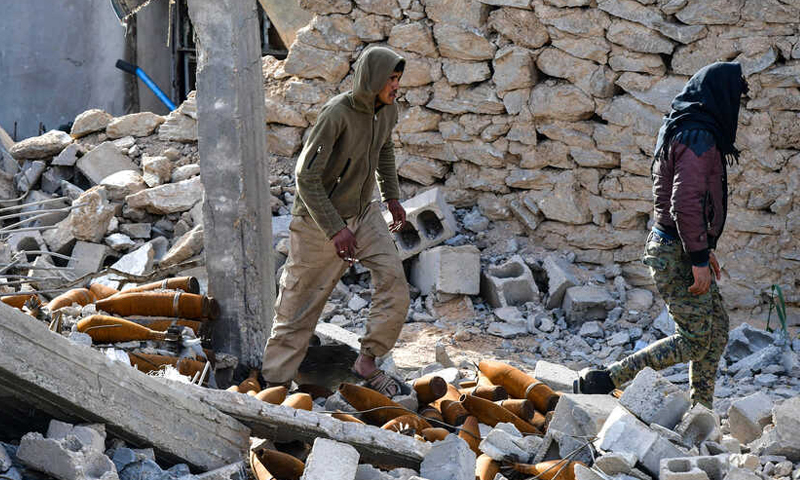



Deir Ezzor-Hussam al-Omar
Muhammad grazes his sheep aided by a wooden crutch, which he started using to mobilize since he lost one of his feet upon stepping on a landmine left by the Islamic State (IS) somewhere on al-Baghouz town’s outskirts in the eastern countryside of Deir Ezzor governorate.
Muhammad Jadaan, a young man in his twenties, is a victim of explosive remnants of the battles fought by IS fighters in their last strongholds against the Syrian Democratic Forces (SDF) fighters in early 2019.
Although it has been two years since the SDF announced the total elimination of IS, with the support of the International Coalition on 23 March 2019, landmines and explosive remnants of war (ERWs)—laid in farmlands and within homes of al-Baghouz and its outskirts—continue to pose lethal risks to the lives of al-Baghouz residents and prevent them from resuming life as normal.
There are no accurate statistics on the number of mines and EWRs in al-Baghouz. However, residents interviewed by Enab Baladi estimated that 70 percent of al-Baghouz houses are infested with mines.
They also indicated that mine explosions are not recurrent, but as more people returned to their homes in al-Baghouz, mines have been increasingly going off.
The IS’s most used war strategy against rivals is booby traps and landmines. The extremist group left thousands of mines and improvised explosive devices (IEDs) in the cities that it once controlled, planted mainly in civilian homes and some public facilities.
Vast numbers of mines and EWRs have been located in the cities of Raqqa and al-Tabqa, as well as in the countryside of Deir Ezzor.
Data on landmines-caused injuries or deaths since the SDF took control of al-Baghouz are similarly lacking.
However, there have been at least seven confirmed deaths due to such explosions, in addition to mild and moderate injuries and limb amputations in the last three months, a health worker told Enab Baladi.
The health worker, who declined to be named because he did not have a permit to speak to the media, confirmed that the situation is getting more dangerous in al-Baghouz, especially that many people from al-Hol camp returned to their homes in the town. These people were allowed to leave al-Hol camp in the governorate of al-Hasakeh, which included hundreds of families who fled the area after the battles between the SDF and the IS intensified.
Over the past few months, scores of families returned from al-Hol camp, controlled by the SDF, to their villages in the countryside of Deir Ezzor. This took place after the President of the Executive Committee of the Syrian Democratic Council (SDC), Ilham Ahmed, stated on 4 October 2020 that the SDF concluded an agreement with the Autonomous Administration that includes evacuating all Syrians from al-Hol camp.
Farhan al-Anou, a 40-year-old resident of Hawija Khanafer, locally known as al-Baghouz camp, took a mother and her children to the emergency room. A mine blasted while the mother cleaned her house, to which the family returned in late 2020.
He told Enab Baladi that one of the children died due to lacking medical equipment and medicines in the health center of al-Baghouz town.
Al-Anou also complained about the high costs charged by private hospitals. Severely injured people are sent to private hospitals because the town’s health center cannot offer them adequate treatment and care. Affected people have been paying bills they cannot afford to survive.
The health sector worker acknowledged the poor health services provided to the population. Simultaneously, he said that the situation will get better mainly with efforts to reactivate the hospital of the town of Abu Hamam in the eastern countryside of Deir Ezzor. In addition to that, work is finally underway to restore Hajin National Hospital, which will support the only clinic in al-Baghouz.
One of al-Baghouz’s prominent tribesmen described to Enab Baladi the unbearable burdens the town suffered due to combat, particularly mines and EWRs, which he called “the seeds of death.”
The tribesman, who declined to be named, told Enab Baladi that the al-Baghouz town people made numerous appeals to the International Coalition to remove mines and other explosive devices in the area. In recent meetings held between the coalition and delegates representing the people of the region, representatives demanded the formation of teams specialized in removing landmines and unexploded ordnance from the area, such as mortar and artillery shells. However, none of their requests has yet been met.
A group of young people from the town of al-Baghouz created a volunteer team to clear mines and remnants of war. However, the team members still have not developed any of the job’s necessary skills or experience, while the only assistance they are offered by the SDF-affiliated Military Council of Deir Ezzor has been some landmine detection equipment.
A member of the voluntary team, who declined to be named for security reasons, told Enab Baladi that the team was established because of the International Coalition’s and the SDF’s delay in responding to the calls of the families after repeated explosions of mines in which children are often the victims.
According to the team member, the most prominent challenges facing the mine detection team members are the lack of sufficient experience and the excessive number of mines in some sites. He added that the area needs specialized teams like the Mine Engineering Division of the Internal Security in the city of Raqqa, which had a major role in the disposal of the remnants of war in the region.
if you think the article contain wrong information or you have additional details Send Correction